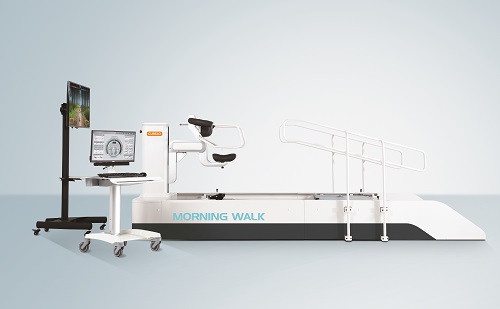- The purpose of rehabilitation: minimizing disorder by curing the fundamental cause
- Increasing emphasis over time on the importance of various fields of rehabilitation medicine
- Benefits to more people if the National Health Insurance Service covers robotic rehabilitation
As the number of senior citizens, traffic accident patients, and patients with cancer or brain diseases are increasing around the world, the importance of rehabilitation is becoming more emphasized each day. Rehabilitation medicine covers a wide variety of ranges-such as musculoskeletal diseases, brain diseases, spinal nerves, developmental disabilities, cardiac rehabilitation, and cancer rehabilitation, etc. Specializing in rehabilitation therapy for stroke patients, Professor Myoung Hwan Ko, of Physical Medicine and Rehabilitation, Jeonbuk National University Medical School, talked about robotic rehabilitation.

- Many people feel unfamiliar with rehabilitation therapy and rehabilitation medical equipment. Does rehabilitation medical equipment have actual effects on patients?
First, you need to know about rehabilitation medicine to understand rehabilitation equipment. The most familiar type of rehabilitation is probably physical therapy. In other words, patients with sore or aches in their muscles often visit a physical therapy clinic, and this is the essential field of rehabilitation medicine. Thus, a lot of the medical equipment used in the clinics is represented as rehabilitation equipment.
Also, medical equipment for patients with brain diseases like stroke and traumatic brain injury, Alzheimer’s disease, and spinal cord damage and children with developmental disorder help with improving arm, leg, and cognitive functions and daily living activities, which is a viral rehabilitation device, including robotic rehabilitation equipment.
- What is your medical specialty and how are you proceeding with rehabilitation therapy?
I am in charge of rehabilitation for brain diseases, especially stroke patients. Typically, rehabilitation can be easily seen as an aid that enhances the remaining functions or the assist with rehabilitation of patients whose disorders had developed. To fully understand rehabilitation therapy, the concept that it is rather a “treatment” for symptoms needs to be established.
For example, hemiparesis caused by stroke should not be understood as a disorder, but a “symptom” resulted from the stroke. Rehabilitation therapy for stroke patients is about treating or minimizing the symptoms of tetraplegia with the best method possible, not simply helping those with disorders already developed.
More specifically, it is enabling the proper movement of arms and legs by reviving the brain (brain reorganization through brain plasticity) damaged by stroke. For this to happen, comprehensive rehabilitation methods—physical, occupational, speech, and cognitive therapies—are in use and drug treatment is also an important method. Another therapeutic method that is now considered significant is robotic rehabilitation.
- As medical robots are effectively operated in the sites of rehabilitation therapy, what are the advantages of using robots for the treatment?
If there are abnormal symptoms in exercising the limbs followed by problems with nerves or musculoskeletal system, then understanding the patient’s current condition and continuing repetitive exercises with accurate motions are vital above everything else. Before the development of rehabilitation robots, a medical team or a therapist had had to assist the patients one at a time for each motion. In severe cases of motor paralysis, several therapists had been needed for a single patient’s treatment. But, after the development of the medical robots, the necessary movements for the treatment became possible to be performed more accurately, correctly, and repetitively.

- What is your opinion on the rehabilitation robots not being applied to many medical sites despite the benefits of rehabilitation?
In South Korea, a treatment method can be supplied throughout the country depending on whether the government approved it for national insurance coverage or not. The robotic rehabilitation is currently not covered by the insurance. But robotic rehabilitation equipment is extremely costly. Thus, since the treatment is applied to patients as a limited, hard-to-access service, it is hard to use widely.
Medical society associated with robotic rehabilitation has been officially requesting for the treatment to be covered by medical insurance. Yet, the government is refusing to approve as requested. This is probably because of the claim, "Repetitive exercise can be continually provided by a therapist, so why insist on using robotic devices?" Hence, researchers of related associations or societies will need to carry on their studies of robotic rehabilitation and, as a result, present outstanding benefits of the robots.
- Based on your continual cooperation with medical equipment manufacturers for “Technical Development Program for the Commercialization of Core Medical Equipment” and “Three Consecutive Years of Technology Transfer,” what is the importance of cooperation between the manufacturers and hospitals?
In the past, the manufacturers had first developed certain medical equipment and then convinced doctors to use it for its high effectiveness. But when applied in the actual medical sites, various problems or inconveniences occurred, resulting in its burial.
If medical specialists and developers of the company build medical equipment as a team even from the initial stage of forming ideas-the best new products will be created to be actively used in medical sites. Hence, cooperation is very significant. Also, consider that the ideas for new medical equipment derived from the medical teams in sites often fade away.
The establishment of a cooperative platform between hospitals and companies can complete beneficial products by directly applying the ideas from those medical sites to the development. Thus, in terms of developing medical equipment, the cooperation between hospitals and companies is seen as reasonable.
- What is the competitiveness of the Korean medical equipment compared to that of overseas countries?
It has a competitive price. I also think it is quite advanced concerning technology. Besides, medical treatment may bring different results depending on the race; so, consider no matter how widely known the imported medical equipment is, it is not always applicable in domestic settings.
- Now that you have been recently assigned for the “Rehabilitation Robot Testbed Project,” what is your goal?
With aid from the National Rehabilitation Center, we launched the Rehabilitation Robot Testbed Project, in which the goal is to increase the availability of domestic rehabilitation robots in real medical fields. Despite the numerous advantages of rehabilitation robots, they are not yet distributed throughout the country.
Through this program, I am looking forward to unveiling the excellence of domestic rehabilitation robots by actively utilizing them to patients, increasing the accessibility, and by continual research on them. Also, based on this, I’d like to contribute as best as I could to the greater utilization of domestic rehabilitation robots not only in Korea but also overseas medical sites.
- For rehabilitation patients, returning to their daily life is most important. What are the things they need to do at home after hospital care?
It’s heartbreaking that there are many cases in which patients who had ardently gone through rehabilitation at rehabilitation hospitals returned to life in bed at homes or sanatoriums. Once discharged from the hospital, help from the family is very significant. Of course, they cannot stick with the patient 24/7. That is why various support and benefits for them exist in our country. You can easily check them out at nearby community service centers. Besides, actively look for help from daycare centers and community welfare centers.
Many patients need to receive rehabilitation and take medicines in parallel. Especially since stroke is most likely to reoccur, continuous drug treatment is significant in terms of prevention. In short, remember the need to stay fit while regularly visiting the hospital.


